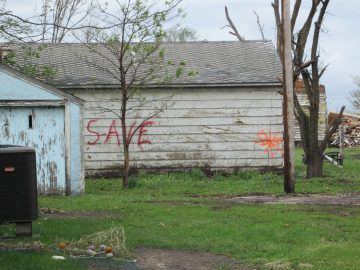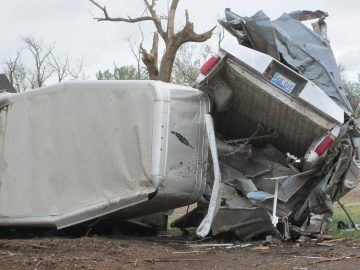by Holly A. Case
 On Sunday, May 17, 2015, there was a Lutheran church service in Delmont, South Dakota. Just one. A week earlier—on Mother’s Day—there had been two, one at Hope Lutheran, another at Zion Lutheran. At around 10:45 that morning, during Sunday school at Zion Lutheran, a tornado had ripped through the town, taking out 40 homes and sucking the roof off of Zion Lutheran. A woman later told us there was a pipe organ “trapped” inside, as if it was a living victim of the storm.
On Sunday, May 17, 2015, there was a Lutheran church service in Delmont, South Dakota. Just one. A week earlier—on Mother’s Day—there had been two, one at Hope Lutheran, another at Zion Lutheran. At around 10:45 that morning, during Sunday school at Zion Lutheran, a tornado had ripped through the town, taking out 40 homes and sucking the roof off of Zion Lutheran. A woman later told us there was a pipe organ “trapped” inside, as if it was a living victim of the storm.
Nine people were injured; no one was killed. “We have four solid blocks of nothing,” said Delmont’s mayor in an interview with a journalist a few days later.
Delmont was a town of roughly two hundred inhabitants pre-tornado. It has fewer than half that now. Sixty maybe. A week after the tornado, I and some of my family went to the Sunday service at Hope Lutheran. We figured most of the town would be gathered there since pretty much all of Delmont was Lutheran. We also presumed the differences between Lutherans to be insignificant.
The pastor at Hope mentioned Zion during the sermon, expressing sympathy for its congregation and sadness over the fate of its church. He also said he’d found a Bible standing upright on the ground as he was leaving town that Sunday, and even knew whose Bible it was. Still, no one from Zion had come to Hope that Sunday. This was evident from a display board with numbers hanging at the front of the sanctuary. One number gave the church attendance the previous week (32), another the amount of the offering ($548), then the attendance that time last year (35), and a final figure gave the average attendance over the previous year (36). I looked around and counted; we alone accounted for the increase in attendance. The Zion Lutherans, we later learned, had caravanned thirteen miles to Emmaus Lutheran in Tripp that Sunday.
In an opening prayer the pastor mentioned the names of families directly affected by the tornado. They were mostly German-sounding names; quite a few. Later the children were called to the front for a biblical story and prayer. A little boy from the pew behind ours took two giant foam letters, “C” and “E,” up with him, one in each hand. The pastor asked him about his letters.“What’ve you got there, Aaron?”
Then the story began. As we all listened, another young boy kept interrupting the pastor, something about a castle. The boy’s father, sitting in the front row, tried to shush him, but the pastor intervened to say it was an important observation—had we all not just been singing “A Mighty Fortress is our God”? And was a fortress not basically a castle? Then the boy blurted out that his house had blown away in the tornado. The pastor, clearly distressed, with the boy’s father now in tears in the front row, suggested a prayer. The boy immediately entered recitation mode: “Our Father who art in heaven, hallowed be thy name…” The pastor went along with it, as did we all, even though the Lord’s Prayer was only supposed to come later. For the rest of the service the boy clung to his father, a great hulking man in a blue shirt, who clung back. Aaron sat in his mother’s lap reciting the alphabet out loud.
The hymns had clearly been carefully chosen for the occasion: to encourage steadfastness, generosity, courage. During the longer prayer the pastor mentioned several names of locals serving in the armed forces who were deployed overseas.
That Sunday it rained on and off, from mist to downpour in a minute, and then slashes of sun. A map on the wall of the volunteer van showed the path of the tornado, which had crossed the west side of town, obliterating everything in its path. We were issued thin plastic rain ponchos and loaded onto a trailer designed for use during the Kuchen Festival, the one big event held in Delmont every year on the second weekend of September.
The two Lutheran churches and the Kuchen Festival speak to the German origins of the town. The cornerstone of Zion is engraved with the words “Erbaut im Jahr 1912 A.D.” (Built in the year 1912 A.D.) A fourth-generation Zion Lutheran and distant relative of its original founders rescued the stone. A journalist recorded this exchange:
Jim Kaufman: The cornerstone is at my farm right now. It’ll be waiting for a new building.
Tad Kaufman: We’ll incorporate it somehow.
Jim Kaufman: We’ll put it someplace to remember the old church.
The houses and outbuildings were all mud-spattered, many with boarded-up windows and large painted “X”s indicating that the structure had been checked for inhabitants. Although the town was just a few blocks square and you could cross the entirety of it on foot in a few minutes, we were forever being offered rides in golf carts or giant pick-up trucks. This made for something akin to traffic. After allowing a truck and trailer to back out of the driveway where we were loading the remains of a shed that that blown apart, strewing shingles and glass across a lady’s backyard, a Red Cross van came by and someone handed four bottles of water out through its side window. The contrast between the excessive vehicular activity and the quiet emptiness of the devastated west side was striking, and, we later reflected, probably not coincidental.
A group of Hutterites from the nearby colony had showed up earlier in the week as volunteers. They did clean-up work all day and then left without returning the rakes, a local told us, in a tone more gossipy than scandalized.
 Across the street from our first cleanup site we saw a livestock carrier twisted like the top of an anchovy can, part of its top wrapped around the truck to which it was hitched, windows blown, body pocked with dents from debris. Someone who had weathered the tornado in his basement said it had actually been pretty quiet as it passed, and that he was surprised when he came up and saw the house was destroyed.
Across the street from our first cleanup site we saw a livestock carrier twisted like the top of an anchovy can, part of its top wrapped around the truck to which it was hitched, windows blown, body pocked with dents from debris. Someone who had weathered the tornado in his basement said it had actually been pretty quiet as it passed, and that he was surprised when he came up and saw the house was destroyed.
A man with a jacket inscribed with the nickname “dozy” said he’d lost his house and shed on the edge of town. We talked a bit and I asked him about the difference between Zion and Hope Lutherans. He either didn’t know or didn’t care to say.
Aa few hundred yards away, at the second cleanup site, we found a sheet of compressed board that had sliced into the lawn behind the school, entering so deeply into the ground that it couldn’t be shifted. So we moved on.
A year later we got a postcard inviting us to celebrate the one-year anniversary of the Delmont tornado. There would be a tornado-path tour and a bounce house–obstacle course for kids. “We are Here. We are Blessed,” it read.
